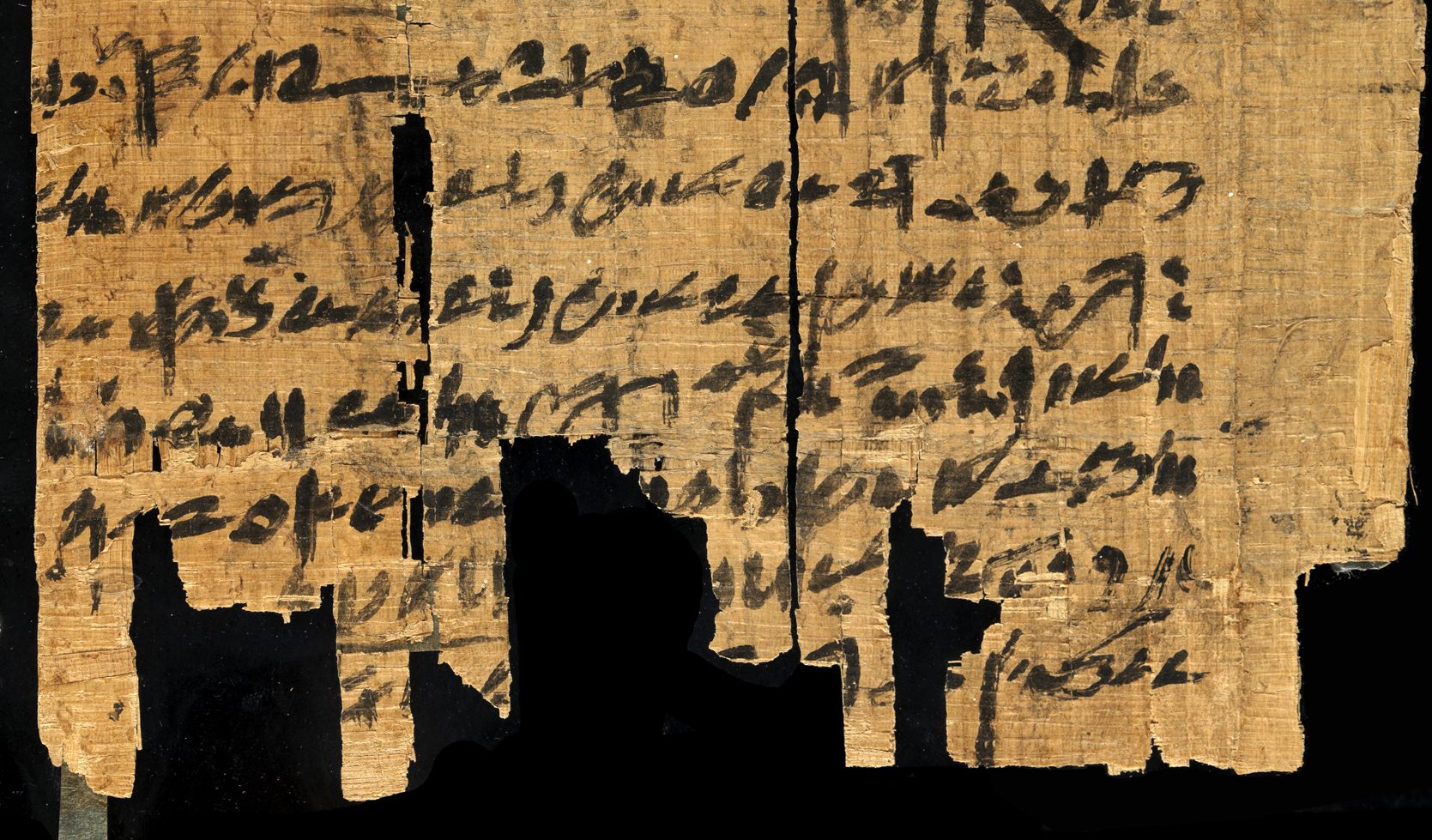P. Louvre E 7852
See more information about P. Louvre E 7852 in Trismegistos’ Demotic and Hieratic Texts [TM 46144].
Recommended edition
K. Donker van Heel, ‘Papyrus Louvre E 7852: a land lease from the reign of Taharka’, RdÉ 48 (1997), 81-93.
Transcription
Transcription of P. Louvre 7852 in PDF
Transliteration
- [Ḥꜣ.t-sp X ı͗bd-Y šmw (sw) 19].
- [ḏd Di͗-]⸢I͗mn⸣-pꜣ-⸢ꜥnḫ⸣ ḥnꜥ I͗mn-pꜣ(y)=f-ı͗t ḥ[nꜥ] Pn-ı͗wı͗w ḥnꜥ […]
- wꜣh-mw Pꜣ-mr-mšꜥ sꜣ ꜥr-n-I͗mn ḥnꜥ Ḫꜣꜥ=w-⸢sw⸣-[n-…]
- ⸢sꜣ⸣ Ḏd-Ḥr pꜣ(y)=f šr dmḏ s 5: ı͗nn ı͗. ı͗r ḏd n=k […]
- ⸢ꜣḥ⸣ nmḥ ḥnꜥ nꜣ 8 sꜣ-tꜣ ꜣḥ nꜣ ꜣḥ […]
- [mn di͗(=i͗)/di͗=n] ⸢md⸣ nb r-ı͗wd.ṱ=w □□ ḏd=w: ꜥnḫ I͗mn ꜥnḫ [Pr-ꜥꜣ ꜥ.w.s.].
- [bn i͗w=n] ⸢rḫ⸣ sṯꜣ.ṱ sẖ nb nty r-ḥry. Pꜣ mtr-sẖ […]
- [M-bꜣḥ] ⸢Ḫn⸣sw-ı͗. ı͗r-dı͗.t=s sꜣ Ḳn-Ḥr ı͗w=f mtr ı͗ sẖ nb nty […]
- ⸢M⸣-bꜣḥ Ḫnsw-ı͗. ı͗r-dı͗.t-s sꜣ Pꜣ-dı͗-I͗mn-I͗p ı͗w=f mtr […]
- […] i͗bd-Y šmw (sw) 19.
Translation
- [Regnal year X, month Y of shemu, (day) 19]
- Have said Diamunpaankh and Amunpa(y)fit and Peniuiu and […]
- the choachyte Pamermesha son of Arenamun and Khâausu[en…]
- son of Djedhor, his son, in total 5 men: “We are the ones who have said to you […]
- private field and the 8 aruras of field, the fields […]
- [I/we do not have] any issue between them.” □□ They said: “As Amun lives, as [Pharaoh life prosperity health] lives:
- [We will not] be able to withdraw any writing which is above.” The witness-scribe […]
- [Before] Khonsirdis son of Qenhor, testifying regarding every writing which is […].
- [Before] Khonsirdis son of Peteamunip, testifying regarding […]
- […] month Y of shemu, (day) 19.
Notes
Line 3: Note that the name Pꜣ-mr-mšꜥ looks very similar to Pꜣ-ṯnf written Pꜣ-ṯrf in P. Louvre E 7856 recto line 3.
Line 6: Read [mn di͗(=i͗)/di͗=n] ⸢md⸣ nb r- ı͗wd.ṱ=w (Archidona Ramírez) instead of [bn i͗w=n] ⸢rḫ⸣ sṯꜣ.ṱ=w (ed. princ.).
Line 9: The determinative of the name Pꜣ-dı͗-I͗mn-I͗p looks like the divine determinative.
Line 9: The reading ı͗ at the end of the line proposed in the ed. princ. cannot be supported by the traces.
Questions about this manuscript
Question 1
The multifunctional sign (p. 12-14 of the course book) is found in lines 3, 7 and 9 (twice), representing ꜣ, the tusk topped by two oblique strokes, the filiation sꜣ and pꜣ, respectively. Try to identify these by just using your eyes, but keep in mind that the multifuntional sign is more often than not written with two strokes rather than as a single sign.
Answer to Question 1
You can easily check the hieroglyphic transcription to see if your hunch was right.Question 2
Gods are an intrinsic part of many abnormal hieratic names. So if you can identify these gods and are aware of the most frequent name patterns (p. 39-41 of the course book), reading an abnormal hieratic text becomes easier. And once it becomes easier, you will gain more self-confidence. So see if you can identify I͗mn (lines 2 (twice), 3, 6 and 9), Ḥr (lines 4 (damaged) and 8) and Ḫnsw (lines 8 and 9).
Answer to Question 2
You can easily check the hieroglyphic transcription to see if your hunch was right.Question 3
Louvre E 7852 contains several instances of the articles pꜣ and nꜣ, but sometimes also as part of a possessive pronoun. Let us find out if you can identify pꜣ in lines 2 (twice, and once in pꜣy=f, here written pꜣ=f ), 3, 4 and 7, and nꜣ in lines 5 (twice) and 9.
